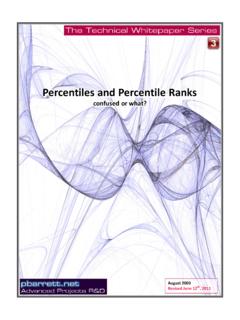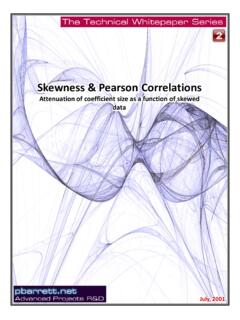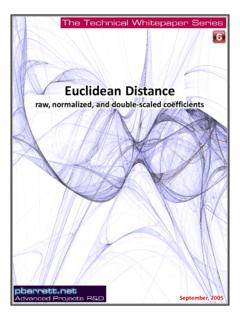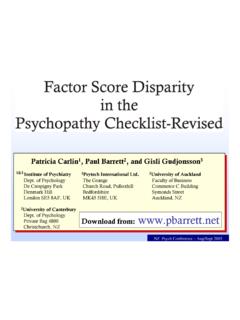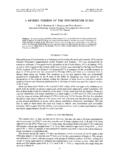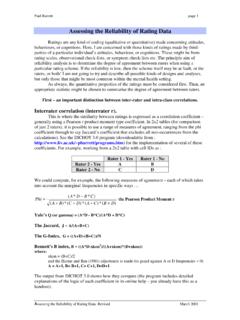Transcription of Pre-Employment Integrity Testing
1 Pre-Employment Integrity Testing : Current Methods, Problems, and Solutions Paul Barrett Chief Scientist & Hon. Senior Research Fellow The State Hospital University of Liverpool Dept. of Psychology Dept. of Clinical Psychology Carstairs Whelan Building, Brownlow Hill Lanark Liverpool ML11 8RP L69 3GB paper presented at: British Computer Society: Information Security Specialist Group March 29th-30th, 2001, Milton Hill, Oxford.
2 Page 2 BCS-ISSG Conference, 29th-30th March, 2001, Oxford Abstract In this paper , the entire range of current and leading-edge methodologies for the assessment of Integrity , honesty, and deception are outlined and briefly reviewed. The relevant evidence for and accuracy of each methodology is also presented. Particular regard is paid to questionnaire measures of Integrity and honesty, as this is the current growth area in psychological Testing for Pre-Employment screening. In order that the paper might also have tangible practical value for the conference members, two tables are provided which list all major tests of Integrity and honesty, along with their publishers.
3 An appendix then lists all the relevant addresses and electronic contact details for each of these publishers. This written paper is targeted as the essential background to the presentation to be given at the conference. The presentation itself moves on from the information presented here, and examines 6 critical problems/issues with the current use of Integrity tests: 1. The axiomatic basis for quantitative scientific measurement within the natural sciences, and the measurement of Integrity , honesty, and personality. 2. Reliability, restriction of range, and corrected validities.
4 3. The nature of the criterion are supervisor ratings really of any value? 4. The use of self-report of counter-productive behaviours who is kidding who? 5. What constitutes accuracy when using an Integrity or personality-based measure, and are validity coefficients of any practical (rather than theoretical) use? 6. The Ethical use of Integrity tests is any employer likely to employ a candidate who scores acceptably on personality and ability measures, but who fails an Integrity test The presentation then proceeds to lay out the solution strategy to effective introduction and use of these forms of psychological screening test within an organisational setting.
5 Page 3 BCS-ISSG Conference, 29th-30th March, 2001, Oxford What is to be measured? And why? A glib answer to the first question is honesty . However, most psychometric test authors and users of the various methodologies for assessing honesty speak of Integrity . The Collins English Dictionary, 3rd edition (1991) defines an honest person as one not given to lying, cheating, stealing etc., trustworthy; not false or misleading, genuine; and characterised by sincerity and candour . Integrity is defined as adherence to moral principles, honesty; the quality of being unimpaired.
6 Thus, the two terms convey virtually the same meaning. However, two other terms have come into usage more recently, employee reliability (Sackett and Harris (1985), and Hogan and Hogan (1989), and counter-productive behaviour (Hollinger, 1986). These two terms reflect the broadening of the meaning of honesty and Integrity from the relatively narrow conceptualisation of theft, lying, and cheating that first defined the overt Integrity tests of the early 1980s, through to a range of behaviours, attitudes, and dispositions that were considered not conducive to efficient and effective work practices or counter-productive to organizational health.)
7 It is in this widening of the definition that the use of personality tests came more to the fore in I/O practice. In answering the second question of the heading above, the most obvious response is that dishonest employees invariably cause loss of profit to the organization. This can be direct (theft of products, services, or property) or indirect (negligent or sabotage behaviours that cause other events to occur that eventually lead to a cost for the organization). Further, those employees who may be considered as holding counter-productive attitudes are likely to influence others around them, having an overall negative or deleterious effect on general employee morale and organizational affect.
8 We are all familiar with the employee who is constantly rubbishing the employer, is passive aggressive (in that they seem to comply with supervisor instructions, but in fact are always trying to sabotage the work in various permissible ways), who encourages other employees to find difficulties with their own work, and who is generally obstructive rather than constructive in any matters of organizational work-practices. This is the essence of counter-productivity. It is not that the employee lacks honesty or Integrity per se, but rather, the employee lacks (or may be said to possess) other characteristics that cause them to have a negative impact within the organizational environment.
9 Available Methodologies for Assessing Integrity and Honesty Figure 1 provides a schematic of all the available methodologies that may be employed by anyone investigating another individual s potential dishonesty and/or counterproductive behaviour/attitudes. Psychophysiology This heading encompasses four subset techniques. The first two are used primarily in conjunction with polygraphy. The polygraph is essentially a recording instrument that will output various biosignals onto either a continuous-feed chart or some other display device, whether electronic or otherwise. The biosignals most usually recorded are all or some subset of heart-rate, blood pressure, skin conductance and resistance, respiration rate and depth, and peripheral skin temperature.
10 Another index sometimes used in tandem with these overt psychophysiological measures is the measurement of pupil diameter changes (pupillometry). The basic premise is that when an individual is lying or evading some truth-laden statement, the individual in essence fears detection. This fear emotion is then hypothesised to cause a change in the individual s physiology can be detected, which can then be used as an index of deceitfulness . As an individual becomes aroused by the deception being perpetrated, we expect to see the heart rate increase, blood pressure increase, page 4 BCS-ISSG Conference, 29th-30th March, 2001, Oxford skin conductance increase, skin resistance decrease, respiration rate increase with perhaps depth decreasing, and skin temperature decreasing (as adrenalin invokes evacuation of the peripheral blood flow).

